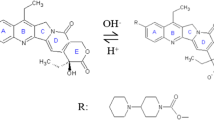Abstract
Implantable and poly (d,l-lactide-co-glycolide) (PLGA) microparticles were developed to deliver temozolomide (TM) continuously in interstitial chemotherapy for glioma. The therapeutic effect of temozolomide/PLGA was evaluated in a rat C6 glioma model. C6 cells were implanted orthotopically into 100 rat brains in 5 groups (n = 20 each): sham operation group, control group, local delivery of blank PLGA microspheres group, oral TM group, and local delivery of TM/PLGA group. Rats in oral TM group were orally administered temozolomide, and rats in TM/PLGA group were locally implanted with TM/PLGA microspheres. Ten rats were selected randomly from each group for observing the survival time, and the other 10 rats were killed on POD 14 to measure proliferation activity and apoptosis of the gliomas. Head MRI examination was performed before the rats were killed. The median survival time of sham operation group, control group, blank PLGA microspheres group, oral TM group, and TM/PLGA group was 19.5, 20, 19, 27, and 46.5 days, respectively. MRI demonstrated that the tumor volume was reduced in oral TM group and interstitial TM/PLGA group. PCNA-positive cell staining showed that proliferation activity of tumor cells treated with interstitial TM/PLGA therapy significantly decreased when compared with that of tumor cells treated with oral TM therapy. The apoptosis of C6 cells in interstitial TM/PLGA group significantly increased when compared with that in oral TM group. Interstitial TM/PLGA was effective in treating intracranial C6 rat gliomas and could prove to be a potential chemotherapy agent for human malignant gliomas.




Similar content being viewed by others
References
Fine HA, Dear KB, Loeffler JS, Black PM, Canellos GP. Meta-analysis of radiation therapy with and without adjuvant chemotherapy for malignant gliomas in adults. Cancer. 1993;71(8):2585–97.
Attenello FJ, et al. Use of Gliadel (BCNU) wafer in the surgical treatment of malignant glioma: a 10-year institutional experience. Ann Surg Oncol. 2008;15(10):2887–93.
Combs SE, et al. Radiochemotherapy in patients with primary glioblastoma comparing two temozolomide dose regimens. Int J Radiat Oncol Biol Phys. 2008;71(4):999–1005.
Wen PY, Kesari S. Malignant gliomas in adults. N Engl J Med. 2008;359(5):492–507.
Brandes AA. State-of-the-art treatment of high-brain tumors. Semin Oncol. 2003;30(6 Suppl 19):4–9.
Wu JY, et al. Association of O6-methylguanine-DNA methyltransferase (MGMT) promoter methylation with p53 mutation occurrence in non-small cell lung cancer with different histology, gender, and smoking status. Ann Surg Oncol. 2008;15(11):3272–7.
Zawlik I, et al. Promoter methylation and polymorphisms of the MGMT gene in glioblastomas: a population-based study. Neuroepidemiology. 2009;32(1):21–9.
Hutchison FG, Furr BJA. Biodegradable polymer systems for the sustained release of polypeptides. J Control Release. 1990;13(2–3):279–94.
Okada H, Toguchi H. Biodegradable microspheres in drug delivery. Crit Rev Ther Drug Carrier Syst. 1995;12(1):1–99.
Higaki M, Ishihara T, Izumo N, Takatsu M, Mizushima Y. Treatment of experimental arthritis with poly(D, L-lactic/glycolic acid) nanoparticles encapsulating betamethasone sodium phosphate. Ann Rheum Dis. 2005;64(8):1132–6.
Menei P, et al. Biodegradation and brain tissue reaction to poly(D, L-lactide-co-glycolide) microspheres. Biomaterials. 1993;14(6):470–8.
Emerich DF, et al. Biocompatibility of poly (DL-lactide-co-glycolide) microspheres implanted into the brain. Cell Transpl. 1999;8(1):47–58.
Bjugstad KB, et al. Biocompatibility of PEG-based hydrogels in primate brain. Cell Transpl. 2008;17(4):409–15.
Zhong Y, Bellamkonda RV. Biomaterials for the central nervous system. J R Soc Interface. 2008;5(26):957–75.
Baker SD, et al. Absorption, metabolism, and excretion of 14C-temozolomide following oral administration to patients with advanced cancer. Clin Cancer Res. 1999;5(2):309–17.
Riccardi A, Mazzarella G, Cefalo G, et al. Pharmacokinetics of temozolomide given three times a day in pediatric and adult patients. Cancer Chemother Pharmacol. 2003;52(6):459–64.
Zhang H, Gao S. Temozolomide/PLGA microparticles and antitumor activity against glioma C6 cancer cells in vitro. Int J Pharm. 2007;329(1–2):122–8.
Paxinos G, Watson C. The rat brain in stereotaxic coordinates. 4th ed. San Diego; 1998.
CBTRUS. Statistical report: primary brain tumors in the United States 2000–2004. In: Edition Published by the Central Brain Tumor Registry of the United States 2008; 2008.
Yung WK, et al. Multicenter phase II trial of temozolomide in patients with anaplastic astrocytoma or anaplastic oligoastrocytoma at first relapse. Temodal brain tumor group. J Clin Oncol. 1999;17(9):2762–71.
Yung WK, et al. A phase II study of temozolomide vs. procarbazine in patients with glioblastoma multiforme at first relapse. Br J Cancer. 2000;83(5):588–93.
Oshiro S, Tsugu H, Komatsu F, et al. Efficacy of temozolomide treatment in patients with high-grade glioma. Anticancer Res. 2009;29(3):911–7.
Trinh VA, Patel SP, Hwu WJ. The safety of temozolomide in the treatment of malignancies. Expert Opin Drug Saf. 2009;8(4):493–9.
Onuki Y, Bhardwaj U, Papadimitrakopoulos F, Burgess DJ. A review of the biocompatibility of implantable devices: current challenges to overcome foreign body response. J Diabetes Sci Technol. 2008;2(6):1003–15.
Brem S, et al. Local delivery of temozolomide by biodegradable polymers is superior to oral administration in a rodent glioma model. Cancer Chemother Pharmacol. 2007;60(5):643–50.
Newlands ES, Stevens MF, Wedge SR, Wheelhouse RT, Brock C. Temozolomide: a review of its discovery, chemical properties, pre-clinical development and clinical trials. Cancer Treat Rev. 1997;23(1):35–61.
Akbar U, Jones T, Winestone J, et al. Delivery of temozolomide to the tumor bed via biodegradable gel matrices in a novel model of intracranial glioma with resection. J Neurooncol. 2009;94(2):203–12.
Acknowledgments
We thank Shen Gao for providing us with the TM/PLGA powder and many valuable suggestions to the study.
Author information
Authors and Affiliations
Corresponding author
Rights and permissions
About this article
Cite this article
Zhang, YH., Zhang, H., Liu, Jm. et al. Temozolomide/PLGA microparticles: a new protocol for treatment of glioma in rats. Med Oncol 28, 901–906 (2011). https://doi.org/10.1007/s12032-010-9531-2
Received:
Accepted:
Published:
Issue Date:
DOI: https://doi.org/10.1007/s12032-010-9531-2




